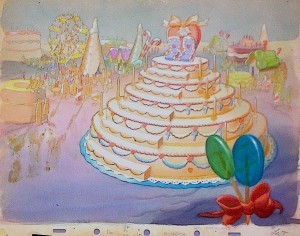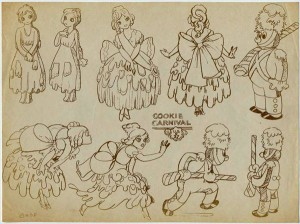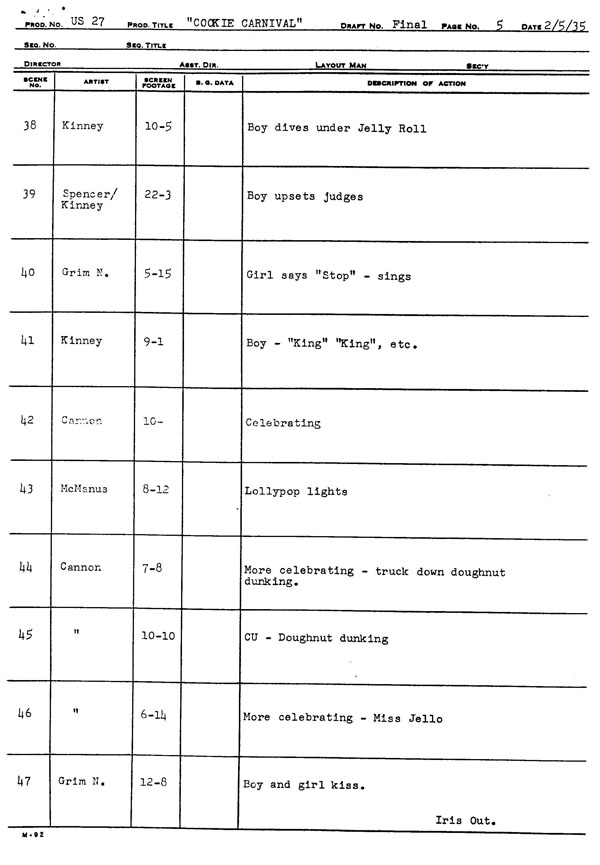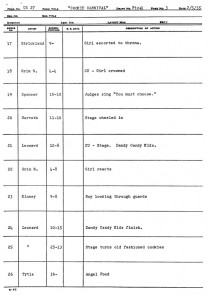
This week’s breakdown is a deliciously sweet Silly Symphony!
After director Burt Gillett’s contract expired at Disney’s in March 1934, he left for the Van Beuren Corporation in New York. Ben Sharpsteen, previously a supervisor to a group of new, young animators, was promoted to director. One of his first directorial assignments was Hot Choc-late Soldiers, intended as an insert for the MGM feature Hollywood Party. The outline for a similar story, set in a world of made from, and populated by, candied sweets, cakes, and other various desserts, circulated around the studio on July 20, 1934.
 In a production memo, written by story artist Bill Cottrell around the same period, Sharpsteen specifically requested this idea to direct. There is no definite credit for the story director of Cookie Carnival. Cottrell mentioned that Pinto Colvig, the voice of the hobo cookie in this film, was involved in those stages during production. The week after the story outline was distributed, Van Beuren released its first color cartoon with similar confectionary settings, Pastry Town Wedding, processed in Cinecolor,
In a production memo, written by story artist Bill Cottrell around the same period, Sharpsteen specifically requested this idea to direct. There is no definite credit for the story director of Cookie Carnival. Cottrell mentioned that Pinto Colvig, the voice of the hobo cookie in this film, was involved in those stages during production. The week after the story outline was distributed, Van Beuren released its first color cartoon with similar confectionary settings, Pastry Town Wedding, processed in Cinecolor,
The Cookie Carnival is Chaplin-esque in nature—a tramp takes pity on a poor woman, and selflessly helps her succeed in her wishes. United Artists, the distributor of Disney’s cartoons, was co-founded by Charlie Chaplin, along with Mary Pickford, D.W. Griffith and Douglas Fairbanks. Elements of the small, telling details in Chaplin’s acting are present in the film; before the hobo cookie comes to the crying girl’s aid, he fashions a candy button on his shirt-front to appear impressionable. Near the end of the film, after he is “crowned” by the cookie guards and proclaimed king by the new cookie queen, the guards and the judges stand to attention, much to his confusion. He acquiesces to the announcement and strikes a regal pose, pleased with his new status.
 Bill Tytla and Grim Natwick were hired at the studio in November 1934, during this film’s production. They received their first Disney scenes for this film; Natwick’s scenes were assigned on November 30, shortly after his arrival. Tytla animates the first scenes with the hobo cookie and the girl, as he comforts and assures she will be the cookie queen. Tytla also animates the scenes featuring the Angel and Devil Food Cakes, two potential “candy-dates” on stage for the cookie queen’s hand in marriage.
Bill Tytla and Grim Natwick were hired at the studio in November 1934, during this film’s production. They received their first Disney scenes for this film; Natwick’s scenes were assigned on November 30, shortly after his arrival. Tytla animates the first scenes with the hobo cookie and the girl, as he comforts and assures she will be the cookie queen. Tytla also animates the scenes featuring the Angel and Devil Food Cakes, two potential “candy-dates” on stage for the cookie queen’s hand in marriage.
Natwick animates most of the scenes of the girl’s makeover. In his animation, there are still traces of his timing from the early sound Fleischer cartoons and Ub Iwerks’ films. The draft indicates that the girl’s transformation was originally assigned to Natwick as a single 81-foot scene; the sequence in the finished film is broken into sectioni wans, assisted by Eddie Strickland and Frank Thomas. (Strickland is credited for a shot of the new cookie queen being escorted to her throne.)
 For a film set in a community with baked goods, a large number of animators are credited in the draft. Some of the artists are given one scene; Don Towsley animates the marching band in the opening, Nick George handles a brief scene of Miss Licorice, one of the selections for the cookie queen, and Paul Allen animates the jolly rum cookies, the last in the line-up of suitors. (The draft credits him as “Paul”; the exposure sheet for the scene confirms that it is Allen.)
For a film set in a community with baked goods, a large number of animators are credited in the draft. Some of the artists are given one scene; Don Towsley animates the marching band in the opening, Nick George handles a brief scene of Miss Licorice, one of the selections for the cookie queen, and Paul Allen animates the jolly rum cookies, the last in the line-up of suitors. (The draft credits him as “Paul”; the exposure sheet for the scene confirms that it is Allen.)
Others are mostly cast by character; Jack Kinney animates most of the scenes with the hobo cookie, and Fred Spencer handles the judges of the pageant. Ferdinand Horvath performed triple duty for this film—he animates some brief sections of the pageant in the opening, and the pages rolling up the jelly roll rug leading to the new queen’s throne; he also designed the characters (with Albert Hurter and Grim Natwick) and painted the backgrounds.
There’s an odd camera cut during scene 3, credited to Horvath, in which there is a nomination for the cookie queen seen at the right, named Miss Peach, indicated by the parade float. However, the action abruptly cuts to scene 4. The background pan continues from the previous scene, but with different characters. In scene 12, a muffin standing at the end of the parade walks behind Miss Orange Crush; she is identified but the figure isn’t shown during the sequence. Concept drawings of these contenders could have made during production, yet it’s interesting they aren’t fully shown on-screen.

The draft was approved on February 5, 1935. The action description in the draft is more succinct than other Disney drafts, which are written in great detail, often including the dialogue. Scenes 15A (“girl through lane of soldiers”) and 22 (“girl reacts”) aren’t present in the finished film; scene 29 is shifted to substitute scene 22, in order to keep much of the focus on the hobo cookie whom introduced her to the masses. Two other candy-oriented cartoons were released in 1935─ Walter Lantz’s Candyland, which preceded Cookie Carnival by a month, and Columbia’s The Bon Bon Parade.
Enjoy the breakdown video! (I’d advise you readers to get a snack for this, since everything looks so tasty…)


(Thanks to J.B. Kaufman and Michael Barrier for their help.)






 DEVON BAXTER is a film restoration artist, video editor, and animation researcher/writer currently residing in Pennsylvania. He also hosts a
DEVON BAXTER is a film restoration artist, video editor, and animation researcher/writer currently residing in Pennsylvania. He also hosts a 





















































































Never knew the Hot Choc-late Soldiers was in color (since the entire feature’s in black n’ white). Kind of a Phantom of the Opera or The Wizard of Oz vibe.
Okay, sorry for being slightly off-topic, but right now I’m more interested in “Hot Choc-late Soldiers”! I’ve got tons of Disney DVD’s, but I don’t remember ever even hearing about this! Thanks for the link, it’s gorgeous. Can it be found on any Disney DVD’s?
I’d be grateful if one of the scholar’s here could write about this — or direct me to a place where I could learn more about it! This certainly seems unique, because how often did Disney do something for another studio?
HOLLYWOOD PARTY is a 2011 Warner Brothers Archive Collection release on standard DVD (mine anyway). Its a 1934 MGM film that Warners now has after they swallowed up the Turner collection. Yes, the HOT CHOC-LATE SOLDIERS number is in color in an otherwise black and white film. It’s worth having for a chance to see Jimmy Durante in his prime along with Laurel and Hardy. You also get to see Ted Healy and his Stooges (Moe, Larry and Curly) before they took flight on their own later that year. I got it in a bargain rack somewhere but you’ll probably have to look for it online. Good luck.
And the “Hot Choc-late Soldiers” is introduced by Mickey Mouse (in B & W), with a combination of animation and live action that includes Mickey interacting with Jimmy Durante.
Thanks for this one, Devon, one of my all time favorite cartoons. I think the rotating cake with the curtains going up to reveal the different suitors influenced the “Carousel of Progress” and “America Sings” attractions at Disneyland. By the way, did Frank Churchill do the music for this one, I’ve always loved the score for this picture.
Nope — it was Leigh Harline that composed the music for this cartoon, Mark.
This is a good example of the “operetta” style of music used in the early Silly Symphonies.
I’ve seen this,too…Warners 1935 “Flowers for Madame” reminded me of this a bit, with a male flower lead character making one of those 30s boxcar trips.
Tytla’s work at Disney was brilliant from the beginning. Even here, you can see him emoting directly through his characters. You can’t teach that kind of thing.
The design of our hobo hero seems to have influenced Richard Williams when creating Tack the Cobbler (from “The Thief and the Cobbler”)